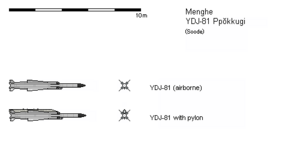YDJ-81 Ppŏkkugi
| YDJ-81 Ppŏkkugi | |
|---|---|
 YDJ-81 with (bottom) and without (top) launch pylon | |
| Type | Anti-radiation missile |
| Place of origin | Menghe |
| Service history | |
| In service | 2012-present |
| Used by | Menghe |
| Production history | |
| Designer | Buksŏng Industries Group |
| Produced | 2011-present |
| Variants | YDJ-81G YDJ-81N |
| Specifications | |
| Weight | 814 kg |
| Length | 5.79 m |
| Diameter | 290 mm |
| Warhead | Shaped charge with prefragmented blast sleeve |
| Warhead weight | 60 kg (total) |
| Engine | Solid fuel booster rocket with liquid fuel ramjet sustainer |
| Wingspan | 1.15 m (diagonal) |
| Propellant | kerosene |
Operational range | 270 km |
| Speed | Mach 2 |
Guidance system | Passive radiation homing with inertial mid-course stabilization and contrast seeker backup |
Steering system | aerodynamic surfaces |
Launch platform | Songrim SR-8 Daesŭngri DS-9 |
The YDJ-81 Ppŏkkugi (cuckoo) is a type of long-range anti-radiation missile developed in Menghe. It was developed to defeat long-range surface-to-air missile systems operated by the Entente Cordiale, including COFFIN-ER, SAMP/T, and the S-300 missile system purchased by Maverica. It can also be used to strike air search radar installations deep behind enemy lines. Apart from its long range, achieve at the cost of a heavy missile body, the YDJ-81's most unique feature is its backup infrared contrast seeker, which can be used to home in on a radar emitter after it switches off.
An "AWACS killer" variant capable of attacking airborne early warning platforms was reportedly under development in 2015. The concept was later rejected in favor of the YGG-9 air-to-air missile.
Precursor systems
YDJ-42
YDJ-42 was the domestic designation given to Letnian Kh-28 missiles produced under license in the Democratic People's Republic of Menghe. Though it had a maximum range of 110 kilometers, the Kh-28 was a large and heavy missile, and its hazardous liquid propellant made it difficult to store and handle.
YDJ-44
Before the introduction of the YDJ-81, Menghe used the YDJ-44 as its main anti-radiation missile. Its original passive radar variant, the YDJ-44G, could match the YDJ-42's 110 kilometer range, this time with the help of a ramjet motor rather than a liquid-fuel engine. Menghe also produced an active-radar variant of the YDJ-44, designated YDH-44, as an anti-ship missile. This system had a shorter range of 90 kilometers.
Menghe introduced a domestic upgrade of the YDJ-44 in 2008. It bore the designation YDJ-44N. In addition to improving the multi-band capabilities of the passive seeker, the upgrade also extended the missile's range to 140 kilometers, enough to exceed the range of the Aster 30 missile used by the SAMP/T missile system.
The introduction of the land-based COFFIN system, however, extended the range of Entente air defense to 180 kilometers, and the sale of S-300 batteries to Innominada and Maverica brought with it the 200-kilometer-range 48N6E2. The S-400 missile system, under development in Letnia with talk of export deals, was rumored to support missiles with ranges of 250 or 300 kilometers. After evaluating the feasibility of a further YDJ-44 variant with doubled range characteristics, engineers in the MoND's common procurement directorate determined that they would need an entirely new missile system to meet such a demanding range requirement, and issued a requirement for a new anti-radiation missile system.
Development
The Buksŏng Industries Group, one of Menghe's main missile development corporations, was responsible for the design and development of the prototype that became the YDJ-81. Buksŏng had previously held the license to the YDJ-44, and had experience in the design of high-speed ramjet missiles. Buksŏng was also simultaneously designing a heavy supersonic anti-ship missile, the YDH-29 Chŏngryong, and drew on the YDH-29's propulsion and guidance systems to accelerate development of the YDJ-81.
Description
The YDJ-81 Ppŏkkugi uses a four-intake ramjet engine, much like the YDJ-44 it replaced. The ramjet intakes are rectangular in cross-section, however, and blend into the missile body differently. The mode of propulsion is also similar, with a solid-fuel booster inside the missile body accelerating the missile to supersonic speeds until that the ramjet can take over and sustain it. Due to the use of a lighter guidance unit, a quasi-ballistic high-altitude cruising pattern, and a more efficient propellant mix, the YDJ-81 can achieve a much longer range of 270 kilometers.
Compared with the YDJ-44, the YDJ-81 also features an improved guidance system. If the radar switches off, the missile "remembers" its bearing and approximate distance and maintains its course on inertial and CSNS guidance. As it draws nearer to a switched-off radar site, the YDJ-81 activates an electro-optical seeker in a pod slung under the missile body. This seeker employs infrared contrast seeking to search for the heat signatures of motor vehicles, running generators, and even sun-heated metal as the missile approaches the suspected area of the radar signal. If the radar emitter does not switch back on, the infrared seeker infrared contrast seeker locks a suspected radar vehicle or building and guides the missile to a direct impact. Compared with dead reckoning in the terminal stage, this method increases the probability of destroying the deactivated target radar or at least destroying a TEL or other battery vehicle. Redundant guidance also increases the damage to other battery components if multiple missiles are fired in salvo at a missile site and the first missile destroys the active radar emitter.
The YDJ-81N, introduced in 2020, reportedly uses a built-in artificial intelligence program to classify infrared vehicle silhouettes by type. It is programmed to prioritize Entente search and guidance radars, then missile launchers, and finally auxiliary vehicles. The artificial intelligence program also helps the missile distinguish between actual vehicles and infrared decoys arranged around the battery site.